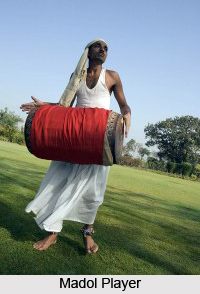 Madol Puja is a folk dance of the West Bengal state of India. It symbolises the worship of drums which are played by the men of depressed classes. The `Madol Puja` or drum worship is considered an important ceremony in many parts of Bengal. The dhak, dhol or madol although played by men belonging to the depressed classes is held in high admiration in various occasions and festivals.
Madol Puja is a folk dance of the West Bengal state of India. It symbolises the worship of drums which are played by the men of depressed classes. The `Madol Puja` or drum worship is considered an important ceremony in many parts of Bengal. The dhak, dhol or madol although played by men belonging to the depressed classes is held in high admiration in various occasions and festivals.
Performance of Madol Puja
During the ceremony of Madol puja, the drummer carries the drum which is worshipped by offering flowers from a kula. The ceremony is also accompanied with the Madol puja dance which exhibits various elegant rhythmic dance movements.
Design of Madol
Madol is also spelled as madal and the ancient name was Mardal. Generally, wood is preferred to construct a madol. The madol has a cylindrical body with a slight bulge at its centre, closed on both ends. It is designed with a strand that goes around the waist of the person who plays it. For comfortable paying of the instrument the person needs to hold it horizontally. Playing technique involves rhythmic struck one either ends with palm which vibrates to produce invigorating sound when struck.
Popularity of Madol in Bengali Culture
The popularity of madol dance is huge in Bengali culture; in fact this musical instrument is an integral part of many occasions. In Bengal, occasions like weddings are celebrated with the accompaniment of `dhol` or `Madol.` On the other hand, in many festivals such as the immensely popular Durga Puja and the Kali Puja, the dhak is employed as an essential instrument. Even during the performance of folk dances in many parts of Bengal the Madol is used as an important instrument to accompany their folk songs.
This article is a stub. You can enrich by adding more information to it. Send your Write Up to content@indianetzone.com



















